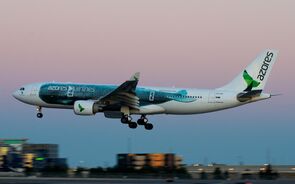Ligeiro rebound?
4 mensagens
|Página 1 de 1
- Mensagens: 41
- Registado: 5/11/2002 7:28
mas,
Mas as quedas irão continuar:
"10 TRIN" Countdown To A Low
As I typically say, "let the countdown begin—yet again!" After a record four "10 TRIN" countdowns during 2002—and after six 10 TRIN countdowns since the Great Bear Market began in 2000— the 10-day average of the Arm's Trader's Index (TRIN) moved above 1.50 yet again. On December 27, it moved to 1.61. THEN, it did it again--moving to 1.53 on January 27, 2003. What's going on? The greatest bear market since the 1930s, that's what!
Let's take another look at the history of this average and what it means for the market when it moves above 1.50.
In 2001, I first presented the following study that I now refer to as "10 TRIN." It is a study of the Dow's reaction to very oversold TRIN readings. This study was first featured in the March 2001 issue of The Global Market Strategist when the "10 TRIN" average moved above 1.50 on March 16, 2001— the first time it had done so since October 1997.
The 10-day average of Arms TRIN had risen to a level greater than 1.50 only a few times in the past forty years, each time leading to a rally soon thereafter. But it has done so a record four times in one calendar year in 2002! Peter Eliades of stockmarketcycles.com first brought this to my attention. Here is an updated table reflecting the history of the 10-day TRIN indicator since 1958 and the number of market days until the final bottom:
May 28, 1962 19 days to final bottom
October 1, 1962 17 days to final bottom
October 7, 1966 Exact day of closing low
May 4, 1970 16 days to final bottom
September 30, 1974 4 days to final bottom
November 19, 1974 13 days to final bottom
March 24, 1980 3 days to final bottom
September 3, 1981 16 days to final bottom
August 6, 1982 1 day to final bottom
October 16, 1987 2 days to intraday bottom
November 30, 1987 4 days to final bottom
October 27, 1997 1 day to final bottom
March 16, 2001 11 days to final bottom
August 15, 2001 23 days to final bottom
January 16, 2002 15 days to final bottom
April 11, 2002 18 days to final bottom
June 6, 2002 34 days to final bottom
September 4, 2002 25 days to final bottom
December 27, 2002 Exact day of closing low, but...
January 27, 2003 ...yet another countdown begins so close to prior event -- unprecendented
During the Great Bear Market in stocks that began in March 2000, the 10-day TRIN has achieved a level over 1.50 only 7 times. On March 16, 2001, the Dow closed at 9823.41 and fell another 716.84 points in 6 calendar days to a March 22 low of 9106.54 before rebounding to an intraday high of 9992.53 on April 2, 2001. The final intraday low occurred on April 4 at 9375.72—a higher intraday low for the Dow than that of the March 22 low of 9106.54, but not for the broader S&P 500 and Nasdaq indices, which did not bottom until April 3 on a closing basis and which included a Nasdaq collapse into its April 4 closing and intraday low.
The next time the 10-day TRIN moved to a level greater than 1.50 was on August 15, 2001, less than one calendar month before the infamous cataclysm of September 11, 2001, and slightly more than one month before the market’s ultimate low for 2001 of Dow 8062.34 on September 21, 2001—the precise due date of our 9-month cycle low. The Dow had closed on August 15, 2001 at 10,345.95—eerily close to its 10,381.73 close one day ago on Wednesday, April 10, 2002. But the Dow fell another 2,283.61 points in 23 market days before the price low was seen.
The September 21, 2001 low constitutes and extreme situation since the mainland of the United States has not been attacked in modern times. Circumstances surrounding the attack that resulted in a 4-day closure of the stock exchange likely contributed to this period registering the longest countdown to a low—23 days. On the other end of the spectrum, the shortest countdown was on October 7, 1966, when the 1.50 reading occurred the precise day of the low.
The April 11, 2002 reading over 1.50 resulted in another 18 days and 369 Dow points before the bottom was reached. But the low was right within the parameters typical for a "10 TRIN Low" as defined by the past 40 years of market action. Further supplementary analysis of the April/May TRIN "episode" was provided in our GMSTechStreet.com Daily Web Update for Traders of April 18, 2002.
Unique and particularly intriguing is the 10 TRIN countdown of June-July 2002. The market had never in its modern history taken more than 23 market days to reach a significant and tradable low after the 10-day TRIN average moved above 1.50. But after the June 6 reading of 1.59, the market took a full 34 market days to bottom—the longest ever. The subsequent 3-week rally was the briefest in duration between readings above 1.50. The 10-day TRIN moved back above 1.50 yet again on September 4, 2002, in month #47 of the 48 that comprise the 4-year cycle, which is due to bottom nominally in October 2002. Presumably, the market is now beginning to set itself up for the 4-year cycle low.
Finally, for a fifth time in 2002, the 10-day TRIN moved above 1.50 on December 27, 2002, the precise day of the low in the Dow Industrial Average. The high number of 10-day TRIN readings over 1.50 during 2002 testifies to the severity of the bear market in progress. Thus far, each price low and rally phase following the beginning of the 10-TRIN countdown has been followed in turn by more bear market lows.
Then, 2003 began with a bang ... with the 1.53 reading January 27, 2003. That means a low any time from January 27 until March 13, 2003 -- 34 days from the initial 1.50+ reading -- if history is a guide!
"10 TRIN" Countdown To A Low
As I typically say, "let the countdown begin—yet again!" After a record four "10 TRIN" countdowns during 2002—and after six 10 TRIN countdowns since the Great Bear Market began in 2000— the 10-day average of the Arm's Trader's Index (TRIN) moved above 1.50 yet again. On December 27, it moved to 1.61. THEN, it did it again--moving to 1.53 on January 27, 2003. What's going on? The greatest bear market since the 1930s, that's what!
Let's take another look at the history of this average and what it means for the market when it moves above 1.50.
In 2001, I first presented the following study that I now refer to as "10 TRIN." It is a study of the Dow's reaction to very oversold TRIN readings. This study was first featured in the March 2001 issue of The Global Market Strategist when the "10 TRIN" average moved above 1.50 on March 16, 2001— the first time it had done so since October 1997.
The 10-day average of Arms TRIN had risen to a level greater than 1.50 only a few times in the past forty years, each time leading to a rally soon thereafter. But it has done so a record four times in one calendar year in 2002! Peter Eliades of stockmarketcycles.com first brought this to my attention. Here is an updated table reflecting the history of the 10-day TRIN indicator since 1958 and the number of market days until the final bottom:
May 28, 1962 19 days to final bottom
October 1, 1962 17 days to final bottom
October 7, 1966 Exact day of closing low
May 4, 1970 16 days to final bottom
September 30, 1974 4 days to final bottom
November 19, 1974 13 days to final bottom
March 24, 1980 3 days to final bottom
September 3, 1981 16 days to final bottom
August 6, 1982 1 day to final bottom
October 16, 1987 2 days to intraday bottom
November 30, 1987 4 days to final bottom
October 27, 1997 1 day to final bottom
March 16, 2001 11 days to final bottom
August 15, 2001 23 days to final bottom
January 16, 2002 15 days to final bottom
April 11, 2002 18 days to final bottom
June 6, 2002 34 days to final bottom
September 4, 2002 25 days to final bottom
December 27, 2002 Exact day of closing low, but...
January 27, 2003 ...yet another countdown begins so close to prior event -- unprecendented
During the Great Bear Market in stocks that began in March 2000, the 10-day TRIN has achieved a level over 1.50 only 7 times. On March 16, 2001, the Dow closed at 9823.41 and fell another 716.84 points in 6 calendar days to a March 22 low of 9106.54 before rebounding to an intraday high of 9992.53 on April 2, 2001. The final intraday low occurred on April 4 at 9375.72—a higher intraday low for the Dow than that of the March 22 low of 9106.54, but not for the broader S&P 500 and Nasdaq indices, which did not bottom until April 3 on a closing basis and which included a Nasdaq collapse into its April 4 closing and intraday low.
The next time the 10-day TRIN moved to a level greater than 1.50 was on August 15, 2001, less than one calendar month before the infamous cataclysm of September 11, 2001, and slightly more than one month before the market’s ultimate low for 2001 of Dow 8062.34 on September 21, 2001—the precise due date of our 9-month cycle low. The Dow had closed on August 15, 2001 at 10,345.95—eerily close to its 10,381.73 close one day ago on Wednesday, April 10, 2002. But the Dow fell another 2,283.61 points in 23 market days before the price low was seen.
The September 21, 2001 low constitutes and extreme situation since the mainland of the United States has not been attacked in modern times. Circumstances surrounding the attack that resulted in a 4-day closure of the stock exchange likely contributed to this period registering the longest countdown to a low—23 days. On the other end of the spectrum, the shortest countdown was on October 7, 1966, when the 1.50 reading occurred the precise day of the low.
The April 11, 2002 reading over 1.50 resulted in another 18 days and 369 Dow points before the bottom was reached. But the low was right within the parameters typical for a "10 TRIN Low" as defined by the past 40 years of market action. Further supplementary analysis of the April/May TRIN "episode" was provided in our GMSTechStreet.com Daily Web Update for Traders of April 18, 2002.
Unique and particularly intriguing is the 10 TRIN countdown of June-July 2002. The market had never in its modern history taken more than 23 market days to reach a significant and tradable low after the 10-day TRIN average moved above 1.50. But after the June 6 reading of 1.59, the market took a full 34 market days to bottom—the longest ever. The subsequent 3-week rally was the briefest in duration between readings above 1.50. The 10-day TRIN moved back above 1.50 yet again on September 4, 2002, in month #47 of the 48 that comprise the 4-year cycle, which is due to bottom nominally in October 2002. Presumably, the market is now beginning to set itself up for the 4-year cycle low.
Finally, for a fifth time in 2002, the 10-day TRIN moved above 1.50 on December 27, 2002, the precise day of the low in the Dow Industrial Average. The high number of 10-day TRIN readings over 1.50 during 2002 testifies to the severity of the bear market in progress. Thus far, each price low and rally phase following the beginning of the 10-TRIN countdown has been followed in turn by more bear market lows.
Then, 2003 began with a bang ... with the 1.53 reading January 27, 2003. That means a low any time from January 27 until March 13, 2003 -- 34 days from the initial 1.50+ reading -- if history is a guide!
Davos
- Mensagens: 41
- Registado: 5/11/2002 7:28
Nasdaq
Nao sei,aqui neste grafico o nasdaq ta em cima da linha!
- Anexos
-
- nasdaily012703a.gif (31.64 KiB) Visualizado 789 vezes
" Richard's prowess and courage in battle earned him the nickname Coeur De Lion ("heart of the lion")"
Lion_Heart
Lion_Heart
Ligeiro rebound?
Possivelmente iremos ter um ligeiro rebound no NDX
- Anexos
-
- oimw012703_04.gif (20.92 KiB) Visualizado 814 vezes
Davos
- Mensagens: 41
- Registado: 5/11/2002 7:28
4 mensagens
|Página 1 de 1
Quem está ligado:


